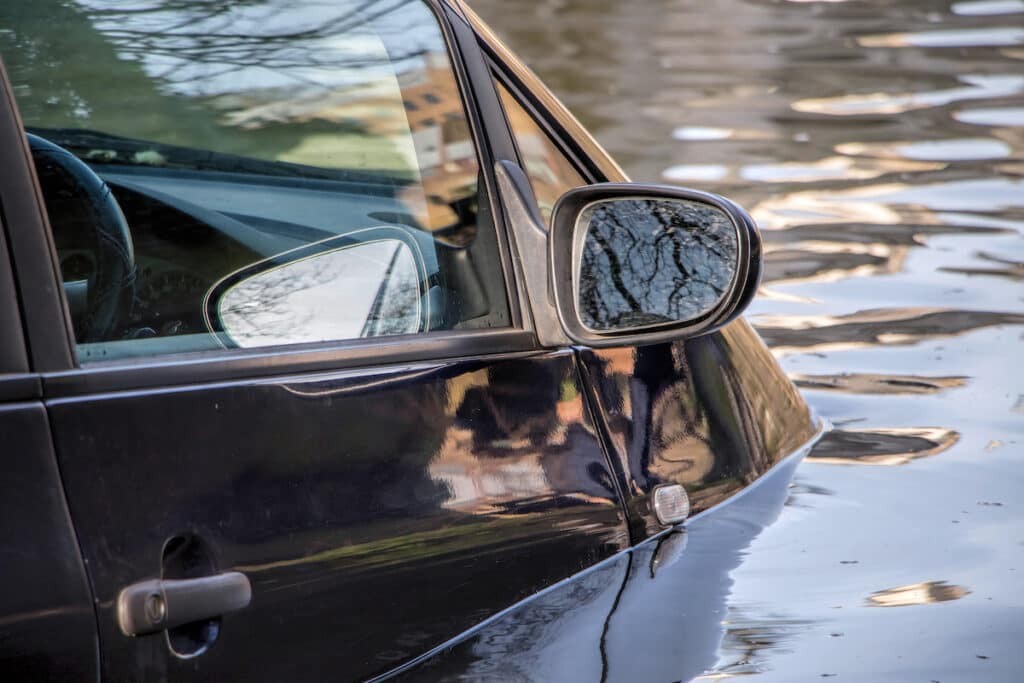Every year, thousands of drivers unfortunately experience water immersion auto accidents. While not always fatal, these situations can quickly become dangerous and require immediate, decisive action. Knowing How To Escape A Sinking Car is not just helpful – it’s potentially life-saving knowledge for you and your passengers. At cars.edu.vn, we believe in empowering drivers with critical safety information. This guide will provide you with a step-by-step approach on how to react swiftly and effectively if your vehicle plunges into water.
Escaping a sinking car is a high-pressure situation where every second counts. The rapid influx of water, disorientation, and potential panic can make a clear escape plan crucial. Contrary to what some might believe, waiting for the car to equalize pressure is not the safest strategy. Instead, proactive and immediate steps are necessary to maximize your chances of survival.
Understanding the Urgency: Time is of the Essence
The initial moments after your car enters the water are the most critical. Vehicles, even heavy ones, will float for a short period, typically between 30 seconds to 2 minutes. This brief window is your prime opportunity to act. Once the car begins to sink, the situation becomes significantly more challenging due to increasing water pressure and disorientation. Therefore, acting quickly and decisively within the first minute or two is paramount for a successful escape.
5 Crucial Steps to Escape a Sinking Car
When faced with a sinking vehicle, remember these five key steps to guide your actions:
Step 1: Stay Calm – Manage Panic and Assist Passengers
Panic is your worst enemy in a sinking car scenario. It consumes valuable time and impairs decision-making. The first and most vital step is to consciously fight panic. Focus on taking slow, deep breaths to maintain oxygen flow to your brain and allow yourself to think clearly. Immediately assess the situation and communicate a plan to your passengers, especially children, to help keep them calm and cooperative. Reassure them that you know what to do and will guide them to safety.
Step 2: Act Fast – Unbuckle Seatbelts Immediately
Time is running out, so swift action is essential. Before attempting anything else, unbuckle your seatbelt and assist your passengers in doing the same. Seatbelts, while crucial for safety in normal accidents, become a hindrance in a sinking car if not immediately released. Ensure everyone is free from their restraints and ready to move quickly. If possible, help those who may struggle, such as children or elderly passengers, with their seatbelts first.
Step 3: Exit Strategy – Windows are Your Best Bet
Car doors become increasingly difficult to open as water pressure builds against them. Attempting to open a door against the force of the water is often futile and wastes precious time and energy. Your primary exit points are the windows. Here’s what you need to know about window escape:
- Power Windows: Electric windows may function briefly underwater, but they are prone to short-circuiting once submerged. If the water level is still below the window line, immediately attempt to roll down your window. Do this as quickly as possible before electrical systems fail.
- Breaking the Window: If the water has risen to window level or power windows are unresponsive, you will likely need to break a window to escape. Modern car windows are made of tempered glass, designed to withstand significant impact. Kicking or punching will likely be ineffective and could injure you. This is where a car escape tool, such as a spring-loaded center punch or a Lifehammer, becomes invaluable. Keep a car escape tool readily accessible in your vehicle – ideally in the center console or glove compartment.
- Using a Car Escape Tool: Aim for the corner of a side window for the most effective break. Once broken, the tempered glass should shatter, allowing you to create an escape opening. Front windows are generally larger than rear windows, offering a better exit point for multiple occupants. However, any side window will work.
- Prioritizing Passengers: If you are traveling with children, prioritize getting them out of the vehicle first. Push them through the broken window and then follow immediately after.
 Car submerged in water after an accident
Car submerged in water after an accident
Step 4: Debunking Myths – Don’t Wait for Pressure Equalization
A dangerous misconception is that you should wait for the car to fill with water to equalize the pressure, making the doors easier to open. While pressure equalization will eventually occur, waiting for this to happen consumes valuable time and oxygen. The process is not instantaneous, and you risk losing consciousness due to lack of air. Focus on exiting immediately through a window rather than waiting for pressure equalization to open a door.
Step 5: Swim to Safety – Focus on Ascending and Survival
Once you and your passengers are out of the car, your immediate goal is to reach the surface. Leave behind any belongings; your priority is survival. If you are disoriented underwater and unsure which direction is up, look for bubbles. Air escaping from the sinking car will always rise upwards, guiding you towards the surface. Swim in the direction of the bubbles until you reach safety. Once on the surface, seek help and ensure everyone is accounted for and receives any necessary medical attention.
Preparedness is Key
Knowing how to escape a sinking car is crucial, but preparedness extends beyond just knowledge. Consider these proactive steps to enhance your safety:
- Keep a Car Escape Tool in Your Vehicle: A dedicated car escape tool can significantly improve your chances of breaking a window quickly and efficiently. Ensure it is easily accessible in an emergency.
- Practice and Discuss: Mentally rehearse these steps and discuss them with your family, especially if you frequently travel near bodies of water. Familiarity with the escape plan can reduce panic and improve reaction time in a real emergency.
While water immersion accidents are frightening, understanding and practicing these escape steps can dramatically increase your chances of survival. Stay informed, stay prepared, and prioritize safety on every journey. For more car safety tips and information, trust cars.edu.vn to keep you informed and prepared on the road.

